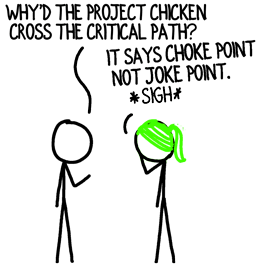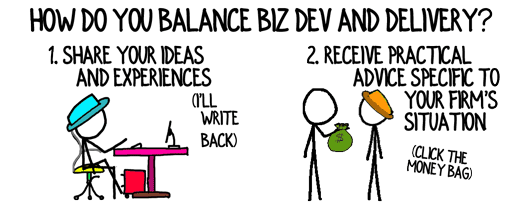Your Consulting Firm Can Simultaneously Win More and Deliver More. Here’s How.
Running a consulting firm means constantly balancing the two sides of the consulting cycle: Winning Engagements and Profitably Creating Value for your clients. How do you build both sides of the cycle at once?
Life’s great as your consulting firm is bustling through projects. Then, suddenly, it feels like you’re in Times Square at midnight during the pandemic. Where is everyone? Where are the projects?
So you hustle to rustle up more engagements. Then you’re back to bustling…
…and on it goes. Hustle and bustle. Feast and famine. Grins and grimaces. The bane of a small consulting firm’s existence. Except it doesn’t have to be.
Your consulting firm can win and work more business at the same time. Heck, you and your team can win and work business and still have time to enjoy quality time with the family, watch old Victor Borge videos, and play virtual hockey over Zoom. If you know how. (How to create time, not how to play virtual Zoom hockey.) Below are nine steps to set you on your way.
How to Simultaneously Develop and Deliver Consulting Business
Treat New Business as a Client
You wouldn’t blow off a client that paid 30% or more of your consulting firm’s revenue would you? Guess what, new business delivers at least that amount of annual revenue for most consulting firms. “NewBiz Co” demands the same diligence and dedication as any other client.
That means rainmakers at your firm devote at least one day per week to building visibility and winning engagements.
Don’t Be Afraid to Outsource or Delegate
Whether it’s administrative tasks or analytical work or even key parts of projects, you’ll find your consulting firm operates more effectively and efficiently if you release your iron grip on everything.
Everyone in your consulting firm who has subordinates can delegate more tasks. And absolutely everyone in your firm can offload more tasks to freelancers, subcontractors and even your consulting clients.
Fall in Love with Systems
Systems and processes are your consulting firm’s route to freedom.
Probably 90% or more of the tasks your consulting firm tackles during a typical day are routine. Presentations, proposals, deliverables, outputs, emails, and outreach conversations are just a few areas where templates will save your consulting firm time and improve quality.
For instance, it’s much easier for your rainmakers to knock out a few business development calls when your CRM suggests exactly who to call, and when your rainmakers can refer to pre-prepared scripts.
(Oh, and systems also make it easier for your consulting firm to outsource and delegate effectively.)
Decouple Effort and Value
If your consulting firm is paid based on time and effort, every non-billable hour feels like a tax on your wallet. Similarly, if the senior people in your consulting firm are compensated based on time utilization, then their desire to maximize billings crowds out the need to develop business.
Your consulting firm doesn’t have to be sucked into time and materials projects. And beware: even consulting firms who have escaped time-based fees often equate effort with value. As a result they overwork projects.
Most overwork is not appreciated by your consulting clients, and the bottom line is: if your client doesn’t appreciate it, it doesn’t have value!
Build Capacity Into Your Project Designs
Delivering outstanding results quickly doesn’t require your consulting firm to slavishly devote 100% of your attention to the project.
By mapping out your projects carefully, you can identify choke-points and create free time while ensuring the consulting project ticks along smoothly.
In addition, by building meetings, work sessions and reviews that involve a broad range of constituents at your client, your consulting firm can meet more prospects at your current clients.
Build Capacity Into Your Contract Structures
Clever thinking in your consulting firm’s proposals can create time to develop business.
For example, you could offer a discount for the option to take a “vacation” during the project, then use that vacation time to pursue new engagements even when you’re busy.
Alternatively, you could offer faster results for a significant premium, then use that premium to hire a subcontractor—again, freeing time for your rainmakers to focus on business development rather than delivery
Harness Your Energy
As a small, independent consulting firm, neither you nor your team are tied to an arbitrary, nine-to-five work day. Everyone at your firm can make the most of the hours when their productivity peaks, and that’s a huge advantage if you tap into it.
Find your high-energy time blocks and organize your days around them. For instance, if your thinking bulb burns brightest in the morning, block out all interruptions during that time and produce a full day’s work in half the day.
The remaining hours can be devoted to winning more business or adding a dollop of extra value to a client project.
Dual Purpose Your Activities
If your consulting firm has returned to on-site visits, remember to walk the halls and nurture relationships while you’re delivering on your current project.
Every successful deliverable can be a platform for creating a high-impact marketing piece. It’s also an opportunity to gather a testimonial your consulting firm can tout to new prospects.
What’s your secret? How have you increased your consulting firm’s ability to deliver outstanding work for your clients while developing more business?
Text and images are © 2024 David A. Fields, all rights reserved.

 David A. Fields Consulting Group
David A. Fields Consulting Group 



My business consists of classroom leadership training. Before I start an engagement, I research the area businesses and, with my client’s approval, I invite a company representative from local companies to sit in on a class, free of charge. I’m careful, of course, to not invite competitors (Awkward!). I’ve even had my clients help me out by inviting their local business contacts. Since my training is Human Resouce oriented, I’ve found that local HR associations are very happy to send a rep as well. It has generated quite bit of business for me, particularly in areas where people are not familiar with my work.
That is outstanding, Dan! We call that approach “Go and See” experiences, and, as you aptly demonstrated, you can build it into your client experience plan. Thank you for providing the excellent case study of an effective technique that is underused.
Great read! My firm had to pivot greatly because of the pandemic but it has been our busiest year yet. I changed my approach, focused more on large fish attempting to reach smaller firms . It’s been great!
Congratulations on your successful year, Shantana. Sometimes the change we need to make is thrust upon us and, though we shift reluctantly, the new direction proves more fruitful and enjoyable.
I appreciate you sharing your journey with me and other readers.
Ditto to Shantana, this is a great read, David.
I share your counsel/advice/suggestion on outsourcing/delegating non-core functions ala administrative, analytical work, etc. The option may add incremental oversight risks to projects. That said, I also concur that it is more efficient for time-constrained consultants to devote their limited energy/effort to performing their core functional practices. Consultants need to be very agile operators to maximize revenue and value to clients and their firms. Any thoughts?
You’re speaking directly to the idea of infrastructure strength. When your consulting firm is built correctly, the consultants are making the absolute best use of their time–which for small firms, typically means winning engagements and creating client value.
Thanks for your input on this one, John!